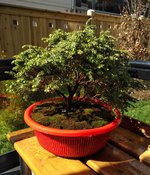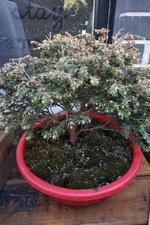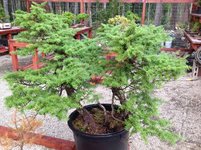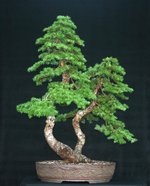You are using an out of date browser. It may not display this or other websites correctly.
You should upgrade or use an alternative browser.
You should upgrade or use an alternative browser.
Moon Frost Canadian Hemlock
- Thread starter Jiminsauga
- Start date
just.wing.it
Deadwood Head
Bare rooting conifers!

That's my kinda confidence!
.....in a colander no-less!
I hope it works out well for you my friend....its a cool little tree for sure.
That's my kinda confidence!
.....in a colander no-less!
I hope it works out well for you my friend....its a cool little tree for sure.
Jiminsauga
Mame
Oh trust me. I'm not happy about bare rooting but I'll make it live... the nursery soil had grubs so I had to react fast.Bare rooting conifers!
That's my kinda confidence!
.....in a colander no-less!
I hope it works out well for you my friend....its a cool little tree for sure.
They were holed up even in the crevices right up to the base of the trunk. Rascals!
penumbra
Imperial Masterpiece
I love every kind of hemlock but I have never completely bare rooted one.
Best of luck.
Best of luck.
Jiminsauga
Mame
If my neighbors didn't already think I was eccentric for growing miniature trees in my miniature townhouse patio area; I introduce to you a miniature greenhouse... 
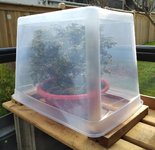
I've used this setup successfully last year to keep my tropicals from drying out in the dead of summer so hopefully it'll be enough to keep humidity up and the wind from drying out the needles.

I've used this setup successfully last year to keep my tropicals from drying out in the dead of summer so hopefully it'll be enough to keep humidity up and the wind from drying out the needles.
Jiminsauga
Mame
penumbra
Imperial Masterpiece
I think the root work was just too much for it. Hope I am wrong but I think its a goner.
Bare rooting a hemlock doesn't sit well with me.
Bare rooting a hemlock doesn't sit well with me.
River's Edge
Imperial Masterpiece
You could add a shallow pan of water below the colander under the tub.
Combination of root work and colander at same time is tricky!
Colanders dry out very quickly on a bench.
Your soil combination is fairly dry as well.
The tray of water below will keep colander damp and provide humidity under the dome.
Do not hesitate to uncover and spray the tree whenever possible. Hemlock respond well to showers
Combination of root work and colander at same time is tricky!
Colanders dry out very quickly on a bench.
Your soil combination is fairly dry as well.
The tray of water below will keep colander damp and provide humidity under the dome.
Do not hesitate to uncover and spray the tree whenever possible. Hemlock respond well to showers
Jiminsauga
Mame
I agree. Looking back I should of half bare rooted and then fully soaked/dunked the other half that was infested with grubs in diluted insecticide for an hour.I think the root work was just too much for it. Hope I am wrong but I think its a goner.
Bare rooting a hemlock doesn't sit well with me.
I got carried away, but lesson learned.
Jiminsauga
Mame
That's a good idea. Nothing to lose at this point.You could add a shallow pan of water below the colander under the tub.
Combination of root work and colander at same time is tricky!
Colanders dry out very quickly on a bench.
Your soil combination is fairly dry as well.
The tray of water below will keep colander damp and provide humidity under the dome.
Do not hesitate to uncover and spray the tree whenever possible. Hemlock respond well to showers
River's Edge
Imperial Masterpiece
If you are making notes I would suggest hemlock repotting earlier next time, prior to the new foliage opening. This would reduce the water requirement immediately after repotting and be safer for the plant. When adapting a root ball from nursery to bonsai form with fine feeder roots the process is usually slower than 1/2 HBR even.That's a good idea. Nothing to lose at this point.
Once hemlock are established with fine feeder roots it is much safer to be aggressive with repots. Basically I treat nursery acquired stock similar to yamadori initially. The key observation that it is safe to be more aggressive with repotting is when the surface area of the container is populated with fine roots that require trimming. If cut back of the roots is required to obtain finer roots then the usual approach is to visualize the root ball divided in six such as a pie and do two at a time to change out soil and promote finer roots.
The drench works well dealing with grubs or insects in the soil.
just some additional information, hope you don't mind.
Jiminsauga
Mame
Not at all! Thanks for the aditional advice.If you are making notes I would suggest hemlock repotting earlier next time, prior to the new foliage opening. This would reduce the water requirement immediately after repotting and be safer for the plant. When adapting a root ball from nursery to bonsai form with fine feeder roots the process is usually slower than 1/2 HBR even.
Once hemlock are established with fine feeder roots it is much safer to be aggressive with repots. Basically I treat nursery acquired stock similar to yamadori initially. The key observation that it is safe to be more aggressive with repotting is when the surface area of the container is populated with fine roots that require trimming. If cut back of the roots is required to obtain finer roots then the usual approach is to visualize the root ball divided in six such as a pie and do two at a time to change out soil and promote finer roots.
The drench works well dealing with grubs or insects in the soil.
just some additional information, hope you don't mind.
I really like the small needles of moon frost hemlock so I won't give up on the spieces just yet. My local nursery brings a few in each year so I will buy another at the year end sell off and try-try again.
Jiminsauga
Mame
@River's Edge in thinking more on what you've said about dividing the root ball and only doing 1/3 at a time. Would cutting off the bottom half of the root ball to get into a training pot be one whole repot season on it's own? Or is it safe to remove said bottom half and still perform the 1/3 bare root?
River's Edge
Imperial Masterpiece
It depends on the condition of the root ball. Hemlock are very dependant on the finer fibrous roots typically near the surface.@River's Edge in thinking more on what you've said about dividing the root ball and only doing 1/3 at a time. Would cutting off the bottom half of the root ball to get into a training pot be one whole repot season on it's own? Or is it safe to remove said bottom half and still perform the 1/3 bare root?
When dealing with nursery raised Hemlock the root ball is significantly different and can vary depending on nursery practices.
If I understand your question correctly, I would interpret it as follows. Is it ok to remove 67% of the root ball in one go? The bottom half plus 1/3 of the remaining!
My recommendation when adapting Hemlock for Bonsai purposes is to deal with 1/3 of the overall root ball at a time. Once the tree is adapted for bonsai use ( has developed the finer feeder roots to enable thriving in a Bonsai pot) then one can adapt more standard repotting practices. However they still need to be applied appropriately within the particular situation.
Using this approach one can typically accomplish a complete repot and change out of old soil in 18 months. 1/3 in the first session, 1/3 in second session and 1/3 in the third session. Typically I would recommend the following timing. First session just prior to bud break in the spring, second session early fall, third session prior to bud break in the following spring. Only proceed to the next session if recovery is evident after the previous session and the tree remains healthy.
With established hemlocks ( those with developed bonsai root ball)I generally repot every two to three years. The amount of work done at that time depends on the soil condition and space remaining for roots to grow.
The amount done is approximately 1/2 but may involve bottom and edges, or central core and top depending on the stage the root ball is at and the condition of the tree.
This tree was developed in this manner and the progress time between pictures is four years from first work involving repots, styling, wiring etc.
First picture ( September 2014) is the collected tree which was placed in large nursery pot after collection with no root work done. Second picture is progress after four years. ( March 2018) I include this to dispel the notion that moving slowly in the beginning with repotting delays development.
Attachments
Jiminsauga
Mame
@River's Edge thanks for taking the time to write such a detailed breakdown on how to approach repotting.
I've seen your top notch hemlock before on the site but never put two and two together. It's a lovely tree.
Hopefully my experience and all the solid advice in this hemlock thread will aid others in the future.
I've seen your top notch hemlock before on the site but never put two and two together. It's a lovely tree.
Hopefully my experience and all the solid advice in this hemlock thread will aid others in the future.
Similar threads
- Replies
- 4
- Views
- 2K

